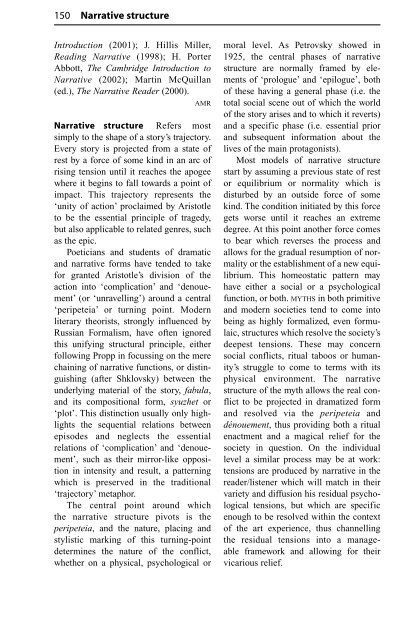The Routledge Dictionary of Literary Terms
The Routledge Dictionary of Literary Terms
The Routledge Dictionary of Literary Terms
You also want an ePaper? Increase the reach of your titles
YUMPU automatically turns print PDFs into web optimized ePapers that Google loves.
150 Narrative structure<br />
Introduction (2001); J. Hillis Miller,<br />
Reading Narrative (1998); H. Porter<br />
Abbott, <strong>The</strong> Cambridge Introduction to<br />
Narrative (2002); Martin McQuillan<br />
(ed.), <strong>The</strong> Narrative Reader (2000).<br />
AMR<br />
Narrative structure Refers most<br />
simply to the shape <strong>of</strong> a story’s trajectory.<br />
Every story is projected from a state <strong>of</strong><br />
rest by a force <strong>of</strong> some kind in an arc <strong>of</strong><br />
rising tension until it reaches the apogee<br />
where it begins to fall towards a point <strong>of</strong><br />
impact. This trajectory represents the<br />
‘unity <strong>of</strong> action’ proclaimed by Aristotle<br />
to be the essential principle <strong>of</strong> tragedy,<br />
but also applicable to related genres, such<br />
as the epic.<br />
Poeticians and students <strong>of</strong> dramatic<br />
and narrative forms have tended to take<br />
for granted Aristotle’s division <strong>of</strong> the<br />
action into ‘complication’ and ‘denouement’<br />
(or ‘unravelling’) around a central<br />
‘peripeteia’ or turning point. Modern<br />
literary theorists, strongly influenced by<br />
Russian Formalism, have <strong>of</strong>ten ignored<br />
this unifying structural principle, either<br />
following Propp in focussing on the mere<br />
chaining <strong>of</strong> narrative functions, or distinguishing<br />
(after Shklovsky) between the<br />
underlying material <strong>of</strong> the story, fabula,<br />
and its compositional form, syuzhet or<br />
‘plot’. This distinction usually only highlights<br />
the sequential relations between<br />
episodes and neglects the essential<br />
relations <strong>of</strong> ‘complication’ and ‘denouement’,<br />
such as their mirror-like opposition<br />
in intensity and result, a patterning<br />
which is preserved in the traditional<br />
‘trajectory’ metaphor.<br />
<strong>The</strong> central point around which<br />
the narrative structure pivots is the<br />
peripeteia, and the nature, placing and<br />
stylistic marking <strong>of</strong> this turning-point<br />
determines the nature <strong>of</strong> the conflict,<br />
whether on a physical, psychological or<br />
moral level. As Petrovsky showed in<br />
1925, the central phases <strong>of</strong> narrative<br />
structure are normally framed by elements<br />
<strong>of</strong> ‘prologue’ and ‘epilogue’, both<br />
<strong>of</strong> these having a general phase (i.e. the<br />
total social scene out <strong>of</strong> which the world<br />
<strong>of</strong> the story arises and to which it reverts)<br />
and a specific phase (i.e. essential prior<br />
and subsequent information about the<br />
lives <strong>of</strong> the main protagonists).<br />
Most models <strong>of</strong> narrative structure<br />
start by assuming a previous state <strong>of</strong> rest<br />
or equilibrium or normality which is<br />
disturbed by an outside force <strong>of</strong> some<br />
kind. <strong>The</strong> condition initiated by this force<br />
gets worse until it reaches an extreme<br />
degree. At this point another force comes<br />
to bear which reverses the process and<br />
allows for the gradual resumption <strong>of</strong> normality<br />
or the establishment <strong>of</strong> a new equilibrium.<br />
This homeostatic pattern may<br />
have either a social or a psychological<br />
function, or both. MYTHS in both primitive<br />
and modern societies tend to come into<br />
being as highly formalized, even formulaic,<br />
structures which resolve the society’s<br />
deepest tensions. <strong>The</strong>se may concern<br />
social conflicts, ritual taboos or humanity’s<br />
struggle to come to terms with its<br />
physical environment. <strong>The</strong> narrative<br />
structure <strong>of</strong> the myth allows the real conflict<br />
to be projected in dramatized form<br />
and resolved via the peripeteia and<br />
dénouement, thus providing both a ritual<br />
enactment and a magical relief for the<br />
society in question. On the individual<br />
level a similar process may be at work:<br />
tensions are produced by narrative in the<br />
reader/listener which will match in their<br />
variety and diffusion his residual psychological<br />
tensions, but which are specific<br />
enough to be resolved within the context<br />
<strong>of</strong> the art experience, thus channelling<br />
the residual tensions into a manageable<br />
framework and allowing for their<br />
vicarious relief.

















